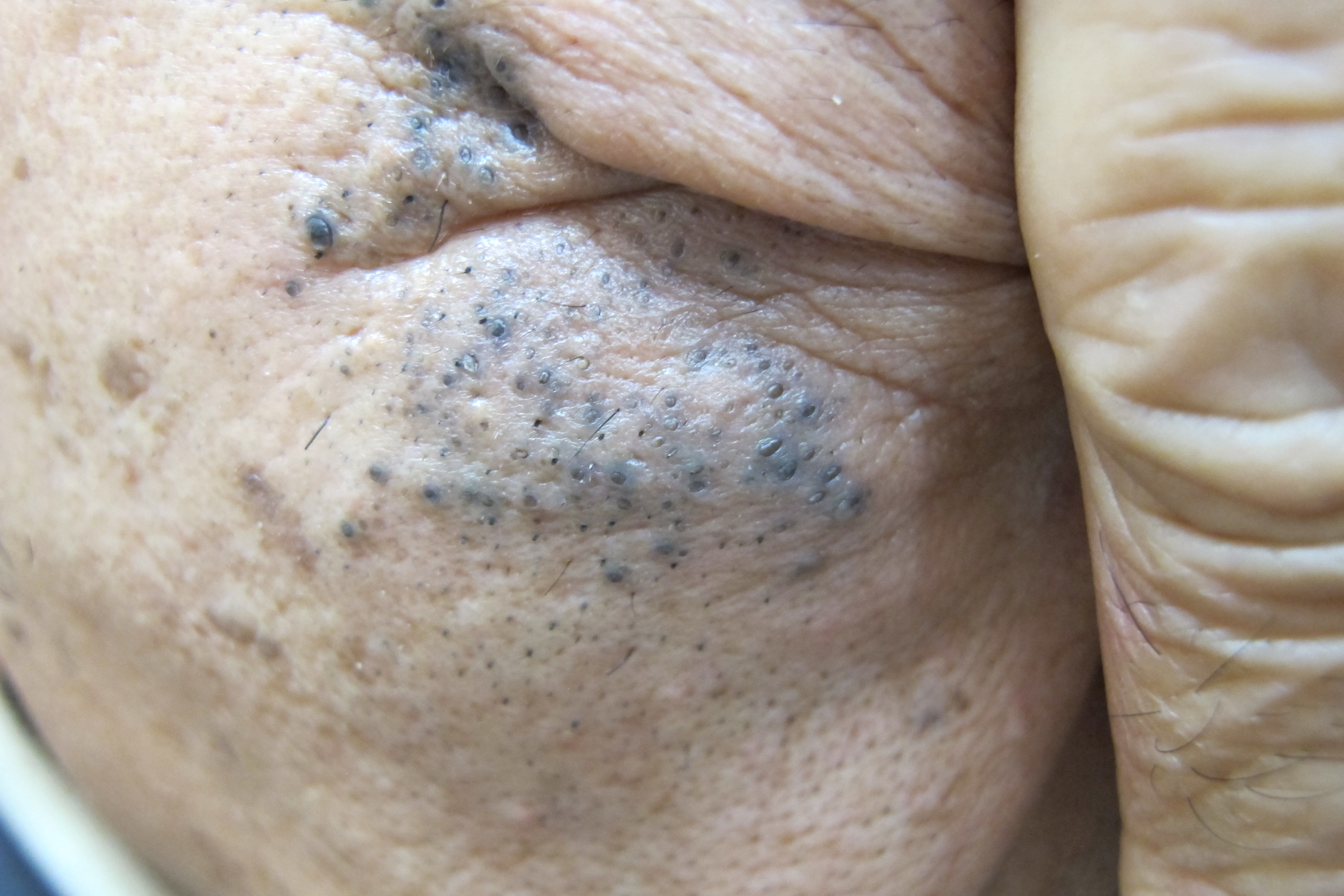Research & Publications > The Hong Kong Practitioner > Clinical Quiz

Clinical Quiz (Please login 'Member Area' for online submission of latest issue)
Clinical Quiz March 2017
This 80-year-old gentleman presented with an asymptomatic plaque on his face near left eye for a few years
King-man Ho
|
Readers are invited to participate in the Clinical Quiz. A prize draw, sponsored by Pfizer Corporation Hong Kong Limited, will be undertaken among the successful entries. For entry into the draw, simply answer the question, fill in the reply slip and return it to the College or submit the answer through the website by 23 May 2017. Each reader is allowed to submit one entry only. The name of the winner and the answer will be published in the June 2017 issue.
|
Clinical history:
This 80-year-old gentleman presented with an asymptomatic plaque on his face near left eye for a few years. The lesion slowly increased in size. The lesions were not symptomatic.
What is the clinical diagnosis?

| A. | Sebaceous hyperplasia |
| B. | Solar comedones |
| C. | Chloracne |
| D. | Comedone naevus |
Answer:
B. Solar comedones
The clinical photo showed a cluster of large pored comedones plugged with black keratinous materials with surrounding changes of photoageing over the infraocular region of an old man.
Solar or senile comedones present with collection of comedones with large opening showing up the “blackheads” on the facial regions of an elderly man. The sites of predilection include the malar ridge, forehead, temples, lateral cheeks and inferior aspect of orbital regions. Some may also associate with a background of yellowish plaque and coarse wrinkles or even furrow, these are features of solar elastosis. In contrast to comedones in acne vulgaris, these comedones seldom trigger any inflammatory response. When the cluster of solar comedones is associated with solar elastosis as shown in the clinical photo of this gentleman, it is referred as Favre-Racouchot syndrome. Larger cysts may sometimes be present. The cause is attributed to prolonged exposure to sunlight and particularly to the cheeks. These are all features of photoageing of the skin. Though “blackheads” are common features of solar comedones and acne vulgaris, the opening of the blackheads in acne are smaller in aperture, besides close comedones and inflammatory papules may be present in acne vulgaris but not in solar comedones. Heavy smoking is also proposed to be an associated factor for Favre-Racouchot syndrome. This is understandable as smokers are more susceptible to photoageing.
Sebaceous hyperplasia is not uncommonly encountered in the elderly and therefore the term senile sebaceous hyperplasia is used as the synonym of this condition. Although it is regarded as a feature of ageing skin, its relationship to photoageing is not as clear as senile comedones. It presents with scattered minimally yellowish to skin colored lobulated papules with a central dimple on the forehead and cheek. The absence of dilated capillary on its surface and more dull yellowish colour help to distinguish sebaceous hyperplasia from basal cell carcinoma. It is a benign condition with almost no malignant potential. Blackheads are not features of sebaceous hyperplasia.
Chloracnes are acneiform eruptions caused by mostly systemic over-exposure to certain halogenated polycyclic or aromatic organic compounds including chlorinated dioxin and dibenzofurans. Apart from the usual features of acne vulgaris like blackheads, pustules and cysts, chloracnes are notoriously known to present with severe nodulocystic and acne conglobata like lesions and the sites of involvement not limited to face and chest. Instead area behind the ears, neck, armpits and groins are involved. Scarring and residual comedones may be left upon cessation of exposure and treatment. These were well described in a few of the industrial accidents in Europe and during the gulf wars perhaps because of chemical warfare. If the exposure to these chemicals is significant, the liver and bone marrow will be affected leading to death. The absence of relevant exposure and severe inflammatory response distinguish solar comedones from chloracne.
Comedone naevus is benign harmatoma presenting usually before the age of 10. It is regarded as a kind of harmatoma involving the pilosebaceous unit. It presents with clusters of numerous dilated comedones filled with keratin plugs arrayed in linear configuration on the face, trunk or neck. It may be a variant form of epidermal naevus. The age of this patient and the background solar keratosis help to distinguish solar comedones from comedone naevus.
The cluster of non-inflammatory wide pored comedones with a background suggestive of solar keratosis in an old man is suggestive of the diagnosis of solar comedones. It is consistent with Favre-Racouchot syndrome.
Sun protection with oil-free sunscreen to exposed skin and cessation of smoking will help prevent further deterioration of solar comedones. Topical retinoid cream albeit may not be very useful is commonly prescribed and tried. Avoidance of using oily facial moisturizing cream is recommended. The contents of the comedones can be squeezed cautiously using a comedo extractor. Despite treatment solar comedones can be very persistent.
The slide and the question were prepared by:
Dr King-man Ho, FRCP (Glasg, Edin), MRCP (UK), FHKCP, FHKAM (Medicine)
Consultant Dermatologist-in-Charge,
Social Hygiene Service, PHSB, CHP, DH
Back
